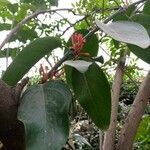Shrub or small tree 1–7 m high; bark brown, deeply fissured; slash cream turning olive green.. Leaves petiolate; petiole 2–7 mm long; blade elliptic or obovate, 4–13.5 cm long, 1.5–8.4 cm wide, acute, obtuse or rounded at the apex, with a hard spiny mucro, cuneate or rounded at the base, coriaceous, glabrous, sometimes puberulous on young leaves especially beneath on lower nerves; secondary veins prominent.. Inflorescence of dense cymes; bracts ovate, 1.3 mm long, acute at the apex, ciliate; sepals ovate, 2.4–3.5 mm long, 0.9–1.6 mm wide, acuminate to acute at the apex, dorsally pubescent or glabrous, ciliate.. Corolla tube pink or red, 12–19 mm long, pubescent or hispid on external surface, rarely glabrous, pilose in the upper half and wrinkled below inside; lobes broadly elliptic, 3.2–4 mm long, 2.5–4 mm wide, acute at the apex, pubescent at the base and mouth of tube, ciliate; stamens slightly exserted, inserted at 12.5–15 mm from the base; anthers ovate up to 1.3 mm long; pistil 13–18 mm long; style 11–16 mm long.. Fruit purple, ellipsoid, 12–35 mm long, ± 25 mm in diameter; seeds 6.6–10 mm long.. Fig. 5/1–4 (p. 16).
Small, perennial tree or shrub, (0.6-)2.0-4.0(-6.0) m high; sometimes multi-stemmed. Leaves ovate-elliptic, oblong to oblanceolate, 50-100 x 20-50 mm, lateral veins distinct, apex acute, ending in a sharp, callose, mucronate point; new leaves red. Inflorescences clustered and many-flowered. Flowers salver-shaped, white. Corolla: tube 8-11 mm long; lobes 2-3 mm long. Anther: apices glabrous. Gynoecium syncarpous. Style 6-8 mm long. Flowering time (Apr.-)June-Oct. (Dec). Fruit an ovoid to ellipsoid, fleshy berry, (8-)10-12(-20) mm long, 10-15 mm in diam., red to purple when mature.
Shrubs to 5 m tall. Branchlets compressed when young, terete with age. Petiole 2-6 mm; leaf blade mostly obovate, occasionally elliptic, 4-10 X 2-7 cm, lateral veins 6-10 pairs. Inflorescences sessile or subsessile, clustered, glabrous or puberulent, usually many flowered; bracts brown or distal ones pinkish, ovate. Sepals ovate to very narrowly ovate. Corolla white to pink, tube 0.8-1.3 cm, glabrous or puberulent outside, hairy inside; lobes broadly ovate, 2-4.5 mm. Berry purplish black, globose, 2.5-3 cm in diam. Seeds semiglobose or semi-ellipsoid, 0.8-1.2 cm. 2n = 22.
Leaves coriaceous, glabrous, smooth or occasionally slightly scabrid; petiole 2–6(7) mm. long; lamina 4·6–10·6 x 1·8–6·7 cm., usually obovate, occasionally elliptic, the apex acute, cuspidate or obtuse, with hard mucro, the base cuneate or rounded; upper surface glossy, with midrib impressed and lateral nerves strongly raised; lower surface mat, all nerves raised, the proximal lateral nerves characteristically reaching the margin without looping to join neighbouring nerves; midrib of lower surface and petiole wrinkled.
A bush or small tree. It grows 8 m tall. The leaves are 5-10 cm long by 2-5 cm wide. They are thick and leathery. They have a sharp spine like point. They are crowded in rings along the stem. The flowers are white or pink. They do not have stalks and are in dense clusters in the axils of leaves. The fruit are a plum shaped berry 1.4-2 cm long. They are bright red but purplish-black when ripe.
Corolla tube 9–13·5 mm. long, pubescent or hispid on external surface or rarely glabrous, pilose within above the middle and wrinkled below; lobes ovate-cuspidate, 2–4·6 mm. long, pubescent or glabrous on either side, usually ciliate.
Small tree or shrub, 2-4 m high. Leaves ovate-elliptic to oblong or lanceolate, acute or obtuse, secondary and often tertiary nerves distinct. Fruit ovoid, rarely subglobose. Flowers white, tinged with pink.
Inflorescences very plentiful, dense, contracted, many-flowered axillary cymes; flowers fragrant, with pink or reddish corolla tube and white lobes.
A much-branched evergreen shrub, sometimes scrambling, or small tree, 1–6 m. high; bark brown, deeply fissured; slash cream turning olive green.
Shrub or tree to 4 m; sap milky. Leaves leathery, ovate, glossy, margins revolute. Flowers in axillary clusters, white tinged pink, fragrant.
Calyx 2–3 mm. long, lobes ovate to lanceolate, weakly imbricate, dorsally pilose and ciliate or glabrous.
Fruit an ellipsoid berry 12–20 mm. long (dry), purple when ripe; seeds 6·5–10 mm. long.
Anthers 1·1–1·4 mm. long, visible in the mouth of the corolla tube at anthesis.
Young branches with reddish tinge, glabrous, conspicuously angled and ribbed.
Ovary 0·6–1 mm. long, ellipsoid, smooth.


